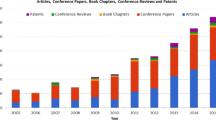Abstract
This chapter shows my creative journey to becoming a female engineer working on the cutting edge of computation and neuromorphic techniques. This chapter shows my real-life journey from early childhood, early education, through my professional career as a faculty member at Georgia Tech. Through this timeframe, I have had the fortune to work on neurally inspired topics, programmable and configurable analog areas, and hel** to develop the future of computation. Through this timeframe I have walked through many non-technical paths resulting in experiences that are part of my larger story.
Access this chapter
Tax calculation will be finalised at checkout
Purchases are for personal use only
Similar content being viewed by others
References
Hasler P (1988) Implementing practical neural networks in silicon. In: Wescon conference, vol SS-1, Anaheim, CA, pp 1–7
Walker M, Hasler P, Akers L (1989) A CMOS neural network for pattern association. IEEE Micro 9(5):68–74
Tsividis Y, Anastassiou D (1987) Switched-capacitor neural networks. Electron Lett 23(18):958–959
Bankman D, Murmann B (2016) An 8-bit, 16 input, 3.2 pJ/op switched-capacitor dot product circuit in 28-nm FDSOI CMOS. In: IEEE Asian solid-state circuits conference
Greenwald R (2007) Quantum Hoops. In theaters starting, Nov 2, 2007
Hasler P, Akers L (1991) A continuous time synapse employing a refreshable multilevel memory. In: International joint conference on neural networks, July 1991, pp 563–568
Hasler P, Akers L (1992) Circuit implementation of a trainable neural network using the generalized Hebbian algorithm with supervised techniques. In: International joint conference on neural networks, June 1992, pp 160–165
Mead C (1990) Neuromorphic electronic systems. In: Proceedings of the IEEE, no 78, pp 1629–1636
Chawla R, Bandyopadhyay A, Srinivasan V, Hasler P (2004) A 531 nW/MHz, 128 x 32 current-mode programmable analog vector-matrix multiplier with over two decades of linearity. In: IEEE custom integrated circuits conference, October, pp. 651–654
Hasler J, Marr HB (2013) Finding a roadmap to achieve large neuromorphic hardware systems. Front Neurosci 7:118, pp 1–29
Hasler P, Diorio C, Minch BA, Mead CA (1994) Single transistor learning synapses. In: Tesauro G, Touretzky DS, Leen TK (eds) Advances in neural information processing systems 7. MIT Press, Cambridge, MA, pp 817–824
Hasler P, Diorio C, Minch B, Mead C (1995) Single transistor learning synapse with long term storage. IEEE Int Symp Circuits Syst 3:1660–1663
Minch BA, Diorio C, Hasler P, Mead C (1996) Translinear circuits using subthreshold floating-gate MOS transistors. Analog Integr Circ Sig Process 9:167–179
Hasler P, Minch B, Diorio D, Mead C (1996) An autozeroing amplifier using pFET hot-electron injection. IEEE Int Symp Circuits Syst 3:325–328
Srinivasan V, Serrano GJ, Gray J, Hasler P (2007) A precision CMOS amplifier using floating-gate transistors for offset cancellation. IEEE J Solid State Circuits 42(2):280–291
Srinivasan V, Serrano G, Twigg C, Hasler P (2008) A floating-gate-based programmable CMOS reference. IEEE Trans Circuits Syst I 55(11):3448–3456
Hasler J (2019) Large-scale field programmable Analog arrays. In: IEEE proceedings
Hasler J (2016) Opportunities in physical computing driven by analog realization. In: IEEE International conference on rebooting computing, pp 1–8
Hasler J (2017) Starting framework for Analog numerical analysis for energy efficient computing. J Low Power Electr Appl 7(17):1–22
Hasler J, Kim S, Natarajan A (2018) Enabling energy-efficient physical computing through analog abstraction and IP reuse. J Low Power Electron Appl 8(4):47
Hasler J (2019) Analog architecture complexity theory empowering ultra-low power configurable analog and mixed mode SoC systems. J Low Power Electron Appl 9(1):4
Hasler J (2017) A roadmap for the artificial brain. In: IEEE spectrum, p 27
Farquhan E, Hasler P (2004) A bio-physically inspired silicon neuron. Int Symp Circuits Syst 1:309–312
Farquhar E, Hasler P (2005) A bio-physically inspired silicon neuron. IEEE Trans Circuits Syst I 52(3):477–488
Gordon C, Farquhar E, Hasler P (2004) A family of floating-gate adapting synapses based upon transistor channel models. Int Symp Circuits Syst 1:317–320
Farquhar E, Abramson D, Hasler P (2004) A reconfigurable bidirectional active 2 dimensional dendrite model. Int Symp Circuits Syst 1:313–316
Brink S, Nease S, Hasler P, Ramakrishnan S, Wunderlich R, Basu A, Degnan B (2013) A learning- enabled neuron array IC based upon transistor channel models of biological phenomena. IEEE Trans Biomed Circuits Syst 7(1):71–81
Lazzaro J, Wawrzynek J, Lippmann R (1996) A micropower analog VLSI HMM state decoder for wordspotting. In: NIPS’96: Proceedings of the 9th international conference on neural information processing systems, pp 727–733
Hasler P, Smith P, Farquhar E, Anderson D (2004) A neuromorphic IC connection between cortical dendritic processing and HMM classification. In: IEEE digital signal processing workshop, Aug, pp 334–337
George S, Hasler J, Koziol S, Nease S, Ramakrishnan S (2013) Low-power dendritic computation for wordspotting. J Low Power Elect Appl 3:78–98
Mead C, Conway L (1980) Introduction to VLSI system design. Addison-Wesley, Reading. ISBN 0-201-04358-0. Early drafts found at http://ai.eecs.umich.edu/people/conway/VLSI/VLSIText/VLSIText.html
Boylan JF (2003) She’s not there: a life in two genders. Broadway Books, New York
One summary overview would be A Girl Like Me: The Gwen Araujo Story, a biography television film, premiered on Lifetime Television in 2006
Hasler J (2017) Must be authentic to be prophetic. Contributed book chapter to Rainbow in The Word: LGBTQ Christians Biblical Memoirs
Small C (Nathan R) (2005) My Freshman year: what a professor learned by becoming a student. Cornell University Press, Ithaca
Zirschky A (2015) Beyond the screen: youth ministry for the connected but alone generation. Abingdon Press, Nashville
Author information
Authors and Affiliations
Corresponding author
Editor information
Editors and Affiliations
Rights and permissions
Copyright information
© 2020 Springer Nature Switzerland AG
About this chapter
Cite this chapter
Hasler, J. (2020). A Creative Path Towards Becoming Female Engineer Enabling the Next Opportunities in Computing. In: Parker, A., Lunardi, L. (eds) Women in Microelectronics. Women in Engineering and Science. Springer, Cham. https://doi.org/10.1007/978-3-030-46377-9_11
Download citation
DOI: https://doi.org/10.1007/978-3-030-46377-9_11
Published:
Publisher Name: Springer, Cham
Print ISBN: 978-3-030-46893-4
Online ISBN: 978-3-030-46377-9
eBook Packages: EngineeringEngineering (R0)




